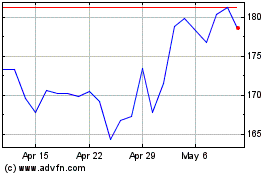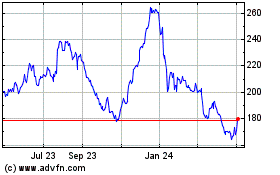By Nancy A. Youssef in Washington, Aresu Eqbaliin Tehran and Rory Jones in Dubai
The U.S. believes that a Ukrainian commercial aircraft that
crashed shortly after takeoff from Tehran on Wednesday was downed
by two surface-to-air missiles fired by Iran, a U.S. official
said.
"We have a high level of confidence that this was shot down by
Iran," the U.S. official said, adding that the plane was being
tracked by Iranian radar just before the two missiles were
fired.
A second U.S. official said the U.S. believes Iran may have shot
down the aircraft by mistake.
One factor contributing to the U.S. assessment that the plane
had been shot down was the large field of debris at the crash site,
the second official said. Planes that crash as a result of
mechanical failure have narrower debris, that official said.
President Trump on Thursday said "I have my suspicions" about
the crash, voicing doubt in remarks at the White House that the
cause may have been mechanical problems.
"I personally don't think that's even a question, personally,"
he said. "It was flying in a pretty rough neighborhood and somebody
could have made a mistake."
The Ukraine International Airlines jetliner crashed shortly
after takeoff from Tehran on Wednesday, killing all 176 passengers
and crew members on board. The crash came amid military clashes
between the U.S. and Iran.
The Boeing Co. 737-800 single-aisle jet crashed after departing
the Iranian capital's Imam Khomeini International Airport en route
to Kyiv, Ukraine.
The investigation into what downed the flight is expected to be
particularly thorny, with heightened tensions between the U.S. and
Iran over the killing of a top Iranian general likely to complicate
international cooperation.
Iranian officials, quoted by the state news agency, said the
plane had suffered a technical fault, that it had started to turn
back in the direction of Tehran airport and was already on fire
before it hit the ground. They said the jet had reached 8,000 feet
before disappearing from radar.
Ukrainian officials said they were considering a number of
possible scenarios, although cautioned they were only preliminary
theories at this stage. Those include a strike by an antiaircraft
missile, a collision with a drone, an engine explosion or a blast
inside the aircraft as a result of a terrorist attack.
No evidence was given for a potential attack. A spokesman for
Ukraine International Airlines declined to comment on
"hypotheses."
The crash came hours after Iran launched missile attacks on U.S.
troops at two Iraqi bases in retaliation for the killing of Iranian
Maj. Gen. Qassem Soleimani. The timing of those attacks raised
questions about whether the Ukrainian airliner was downed by a
projectile.
A U.S. official familiar with the matter said Wednesday that
data transmitted via satellite indicated everything was normal on
the jetliner until the sudden loss of data and the fatal dive. That
data suggest to some U.S. air-safety officials that there may have
been some sort of hostile act, said the person, who also cautioned
that it was too early to draw conclusions.
Iran rejected the notion of a hostile act. "Since the Ukrainian
pilot was trying to return to the airport, a rocket, missile strike
or the country's defense system is out of question," said Hassan
Rezaifar, head of Iran's Civil Aviation Organization commission for
accidents investigation, quoted by Iran's state news agency. "No
missile part was found in the crash scene."
The last high-profile shootdown of a commercial airliner
occurred in eastern Ukraine in 2014, when pro-Russian separatists
battling the central government downed a Malaysian plane with a
surface-to-air missile. All 298 people on board the Boeing 777
died.
A team of 45 Ukrainian experts and officials arrived in Tehran
early Thursday and will be involved in decoding the plane's black
boxes and identifying and repatriating bodies. The team had already
collected DNA samples from relatives of the victims in Ukraine.
"The priority for Ukraine is to establish the causes of the
crash," Ukrainian President Volodymyr Zelensky said. Ukraine said
Mr. Zelensky spoke by phone with Iranian President Hassan Rouhani,
who pledged full cooperation in the investigation, including
sharing all data with Ukrainian officials on the ground in
Tehran.
However, it isn't clear how much access U.S. investigators will
get to the crash site. Iran's Mr. Rezaifar said the probe would be
conducted to international standards set by the International Civil
Aviation Organization.
That would indicate U.S. companies and entities could be
involved. However, Ali Abedzadeh, head of Iran's Civil Aviation
Organization, told the semiofficial Mehr News Agency on Wednesday
that his organization wouldn't provide Boeing or the U.S. access to
the black box.
Based on the International Civil Aviation Organization's
convention, the home country of the airline and the makers of the
plane and its major systems are each entitled to appoint a
representative to participate in crash probes.
Boeing has said it is in contact with Ukraine International
Airlines and is ready to assist in any way. Determining what went
wrong is critical to the plane maker, which already is dealing with
the grounding of its best-selling 737 MAX fleet after two fatal
crashes involving that jet.
The plane that crashed, a 737-800, is the most popular version
of the aerospace giant's workhorse jet. The model and its variants
account for around 25% of all commercial jetliners in operation,
enjoying one of the industry's best safety records.
Georgi Kantchev in Moscow contributed to this article.
Write to Rory Jones at rory.jones@wsj.com and Georgi Kantchev at
georgi.kantchev@wsj.com
(END) Dow Jones Newswires
January 09, 2020 13:03 ET (18:03 GMT)
Copyright (c) 2020 Dow Jones & Company, Inc.
Boeing (NYSE:BA)
Historical Stock Chart
From Jun 2024 to Jul 2024

Boeing (NYSE:BA)
Historical Stock Chart
From Jul 2023 to Jul 2024
